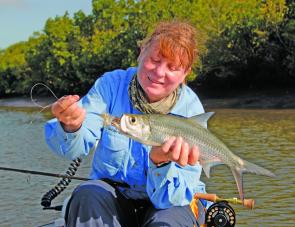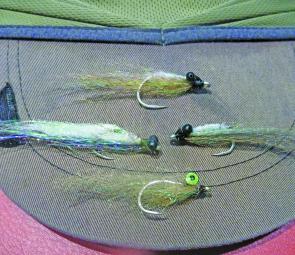Not long after I started fly fishing I read in an interesting article boldly stating that few fish took flies as readily as tarpon.
Infused with this gem of wisdom, and knowing of a lake holding tarpon only two hour’s drive from home, I headed off with fly rod and small fish -like flies to give it a go.
In those early days I had caught very few fish on fly and after that session on the tarpon I decided I was definitely in for a lot of hard time ahead; tarpon are meant to be the easy ones to catch! I didn’t catch one of these slippery streaks of silver. Yes, I saw some but the fly was untouched.
Initial attempts aside I have indeed found that tarpon can indeed be easy marks so long as conditions are right. Cold conditions are out.
There’s no question that these fish are lovers of warm or warming water, yet even in summer blustery cool and windy conditions can reduce activity significantly.
Conversely a warm early morning or evening with just a bit of light breeze can see tarpon rolling happily on the surface. They gulp air then move off and leave a helpful bubble trail as an indicator of direction for the fly’s interception.
The idea is to lead the fish somewhat - allow the fly a couple of seconds to sink and then tweak it enticingly with the rod held well to the side to allow for the trade mark sudden strike that typify tarpon’s attack on a fly.
These fish always seem to attack the fly as they turn away so there’s usually no ‘bite’, just a wrench. While tarpon are the same as most fish in that the lower the tippet diameter the higher the hook up rate, there are definite limits in this regard. A tippet of around 4-5kg breaking strain will ensure that flies stay put and are not broken off so long as the angler is on the ball. Fish lighter than that and you will surely be in for some knotting practice.
A few slow tweaks, a couple of small strips and a pause now and again is the sort of action that will stimulate interest from a tarpon. Remember not to move the fly too quickly, these are not tuna or mackerel but creek or back water dwellers that have plenty of time to feed. Be aware that a small swirl or boil will often precede the hit.
I find a full floating line ideal for tarpon work but sink tip or intermediate sink rate fly lines are also useful. A six weight outfit is ideal, but one can go larger if the fish are inclined that way as well.
I avoid fast sink rate fly lines as the fly needs to be stripped far too quickly just to avoid snagging up. Tarpon can be put off by that sort of really fast retrieve.
Small fish are tarpon tucker so it pays to match the hatch. Flies such as a Crazy Charlie, Clouser, Surf Candy, or Deceiver all with colours reflecting the imitation of a small bait fish - dark brown or olive over silver sides - will interest tarpon if in the mood to have a go. Size 2/0 or 1/0 hooks are best.
Remember to use only the sharpest hooks as tarpon have rock hard mouths. If a fly has seen a bit of action ensure it’s really sharp before tying it on the leader.
Interestingly, these fish seem to have a feeding habit that can make them totally refuse one style or pattern of fly - even though it was successful a previous time - only to be seemingly totally obsessed with another one.
The fish pictured with my wife, Denise, was among a small school of fish that were rolling happily close to the boat but were obstinately refusing our offerings of off white Clousers with black bead chain eyes. The fish would swirl but not hit the fly. Then Denise tied on the same fly with green painted lead eyes and presto! Several fish were snapping at the fly with the fish pictured winning the chance to star in QFM.
I changed fly accordingly and enjoyed a nice session on the acrobatic species. That’s one thing about tarpon that makes them so much fun. These fish jump as soon as the fly takes hold.
Most clean water ways with sea/river access will hold tarpon. Their preferred habitat is the upper reaches of creeks and rivers and are equally happy in either salt, brackish or fresh water. Any back water or lagoon having access to clean water can also hold tarpon.
Boat harbours and some canal estates also have numbers of these interesting fish. The clue to finding them is to look for mullet. If the water is inhabited by mullet there’s a good chance tarpon will also find it a good home. The idea is to take the fly tackle and cast around structure of any kind or simply look for fish rolling. Typically there will be a flash of the large dorsal fin or perhaps the tail as well and then a bubble trial. That bubble trail means you are on the money!
Reads: 2058
Denise holds the tarpon that took a liking to a fly with green lead eyes.

A few proven tarpon flies. Note that there are similar styles but the eyes differ.




